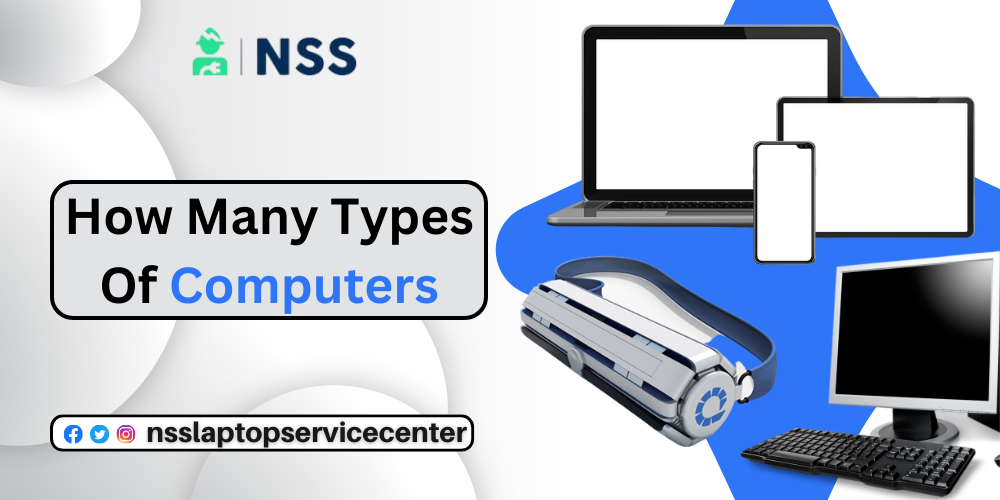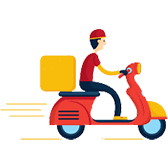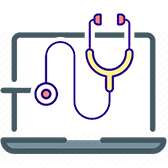
How Many Types Of Computer
"Computers" are a basic need of the present time and represent the state of the world's new features, technology, and innovation. Computers have their history from manufacturing to development. Do you know what the definition of a computer is? And what are the types of computers? If you don't know, don't worry because this article helps you know all the details about computer types.
What Is A Computer?
We see the computer as a machine or device that helps us to do our daily tasks such as making presentations, online meetings, paying bills, office work, school work, etc. But the definition of computer is not so easy as it includes a lot of complex meanings. Still, the most straightforward purpose from which we can define a computer is that "A computer is an electronic machine that is used to store, find and arrange information, calculate amounts and control other devices." Another definition of a computer is "An electronic device programmed to carry out sequences of arithmetic or logical operations automatically and can perform generic sets of operations known as programs."
Also Read: Who Invented Laptops?
What Are The Types Of Computers?
Let's discuss the types of computers used in different fields of the electronic world to fulfill an individual's or system's basic digital requirements. Traditionally, computer classification was based on size, processing speed, and cost. Based on these factors, computers were classified into different parts, such as Supercomputers, mainframe computers, microcomputers, and minicomputers. However, with rapid and continuously changing technology, this classification of computers is no longer relevant. One of the big problems in deciding on the type of computers is that computer technology is changing so fast that new models and versions of computers with much higher performance and cost are introduced in the market every few months and years. The price is also less than the previous models of the latest models. Hence, today, computers are categorized based on their mode of use or the aim for which we use any specific model.
Computers Can Be Classified Into Three Types:-
i. Based On The Size
- Super Computer
- Main Frame Computers
- Mini Computers
- Micro Computers /Personal computers (PCs)
- Desktops
- Laptops (Notebook computers)
- Palmtops
ii. Based On Purpose/Aim
The two primary purposes of computers are:-
- General purpose
- Specific purpose
iii. Based On Data Handling
Based on the mechanism or data handling, computers can be classified into three subtypes:-
- Digital
- Analog
- Hybrid
Computers Based On Size
Based on size, computers can be classified into different types, such as supercomputers, minicomputers, supercomputers, Mainframe computers, Laptops, Workstations (desktops), and PCs (Personal Computers).
1. Super Computers
Supercomputers were some of the most influential and expensive computers at the time. Supercomputers are primarily used to process complex scientific applications and programs requiring massive processing power capacity.
Supercomputers have multiprocessing and parallel processing technologies that can solve complex problems much faster. Some uses and applications that need supercomputers for processing are listed below:
1. We can see the uses of supercomputers in the Petroleum industry as this industry uses supercomputers for analyzing the volumes of seismic data that are gathered during the oil-seeking explorations to identify areas or places where there is the absolute possibility of getting petroleum and oil products inside the earth crust.
2. The aerospace industry also uses supercomputers to simulate airflow around an aircraft that flows at different speeds and altitudes. This specific simulation helps produce effective aerodynamic designs, developing aircraft with improved performance.
3. The automobile industry also uses supercomputers for crash simulations of automobile designs. It crashes simulations released before the manufacturing.
2. Main Frame Computers
Mainframe systems are mainly used for handling mid to vast organizations' data processing needs. Mainframe computers are also used in environments where many users must share a joint computing facility to complete daily tasks.
For example,
There are several organizations such as research groups, educational institutions, engineering firms, banks, insurance companies, hospitals, railways, etc., where mainframe computers are used for processing a large number of online transactions, and this can only be done by mainframe computers as they have massive data storage and processing capabilities.
3. Mini Computers
Minicomputers are generally multiprocessing computers that are of medium size with the lowest maintenance cost. It can support 4 to 250 users simultaneously and is used in billing, accounting, etc. Minicomputers can efficiently perform the tasks of an earlier mainframe computer at a significantly low expense.
4. Micro Computers
Microcomputers are generally known as "Personal computers (PCs)". PCs are non-portable and are general-purpose computers that have a standard size and fit easily on office tables. One person or an individual generally uses PCs at a time. PCs are single-user-oriented, which means one person can use them individually for their needs. Desktops and laptops are the two popular parts of Microcomputers that are used widely.
· Laptops
Laptops are portable computers mainly used by people who need computing resources anywhere or wherever they go. The laptop size is approximately the same as a medium-sized (approximately 11 inches) notebook and can easily be carried anywhere and fit in a bag. Since laptops are lightweight and easy to carry, they are also known as Notebooks. Laptops are also known as personal computers or simply computers used for personal. Laptops are as powerful as a moderate PC, and their small size and light weight allow an individual to use them comfortably anywhere by placing them on one's lap.
· Desktops
Desktops are also a part of microcomputers, and desktops are specifically designed to facilitate the computing needs of engineers, architects, and other professionals who need enormous processing power, more extensive storage, and better graphics display features compared to standard PCs.
For example,
Workstations are also a powerful desktop system used for computer-aided design or CAD, which helps simulate complex scientific and engineering problems and multimedia applications such as generating special audio-visual effects in movies, films, and television programs.
· Palmtops
A handheld computer or one that can be handled alone is known as a palmtop. The size, weight, and design of palmtops are such small computing devices that can be used comfortably by holding in hand. It is known as a palmtop because it can be kept on the palm and operated in the hand effortlessly. Tablets, Smartphones, and Pocket PCs are the types of palmtops.
Computers Based On Purpose
Two primary purposes of computers are general and specific. General-purpose computers come in many different sizes and capabilities, whereas specific-purpose computers come in an exact size that can only deal with some particular operations. General-purpose computers are for general use, whereas specific computers are used for some unique and individual programs and operations.
Computers Based On Data Handling
Based on the mechanism or data handling, computers can be classified into three types -:
· Digital
Digital computers perform mathematical calculations and logical operations at high speed. All laptops, desktops, and smartphones are the new forms of digital computers.
· Analog
The data that changes continuously and cannot have discrete values is analog; analog computers are specially designed to process this analog data. For example, speedometers and mercury thermometers are known as analog computers.
· Hybrid
The combination of digital and Analog computers is known as a Hybrid computer. It carries out the system operation process as fast as an analog computer and has accuracy like a digital computer.
For example,
The processor or system used on petrol pumps shows the converted fuel flow numbers into the price and quantity known as hybrid computers.
Also Read: Difference Between Desktop And Laptop
Also Read: Latest Technology RollTop Laptops
Conclusion:
This article concludes with detailed information about what a computer is and the types of computers based on their size, purpose, and mechanism.
Popular Services
- MacBook Battery Replacement Cost
- HP Printer Repair in Delhi NCR
- Dell Laptop Repair
- HP Laptop Repair
- Samsung Laptop Repair
- Lenovo Laptop Repair
- MacBook Repair
- Acer Laptop Repair
- Sony Vaio Laptop Repair
- Microsoft Surface Repair
- Asus Laptop Repair
- MSI Laptop Repair
- Fujitsu Laptop Repair
- Toshiba Laptop Repair
- HP Printer Repair Pune
- Microsoft Surface Battery Replacement
- Microsoft Surface Screen Replacement




